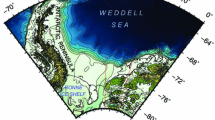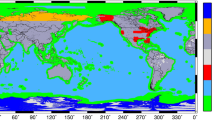Abstract
The paper presents a high-resolution global gravity field modelling by the boundary element method (BEM). A direct BEM formulation for the Laplace equation is applied to get a numerical solution of the linearized fixed gravimetric boundary-value problem. The numerical scheme uses the collocation method with linear basis functions. It involves a discretization of the complicated Earth’s surface, which is considered as a fixed boundary. Here 3D positions of collocation points are simulated from the DNSC08 mean sea surface at oceans and from the SRTM30PLUS_V5.0 global topography model added to EGM96 on lands. High-performance computations together with an elimination of the far zones’ interactions allow a very refined integration over the all Earth’s surface with a resolution up to 0.1 deg. Inaccuracy of the approximate coarse solutions used for the elimination of the far zones’ interactions leads to a long-wavelength error surface included in the obtained numerical solution. This paper introduces an iterative procedure how to reduce such long-wavelength error surface. Surface gravity disturbances as oblique derivative boundary conditions are generated from the EGM2008 geopotential model. Numerical experiments demonstrate how the iterative procedure tends to the final numerical solutions that are converging to EGM2008. Finally the input surface gravity disturbances at oceans are replaced by real data obtained from the DNSC08 altimetryderived gravity data. The ITG-GRACE03S satellite geopotential model up to degree 180 is used to eliminate far zones’ interactions. The final high-resolution global gravity field model with the resolution 0.1 deg is compared with EGM2008.
Similar content being viewed by others
References
Andersen O.B. and Knudsen P., 2009. DNSC08 mean sea surface and mean dynamic topography models. J. Geophys. Res., 114, C11001, doi: 10.1029/2008JC005179.
Andersen O.B., Knudsen P. and Berry P., 2009. The DNSC08GRA global marine gravity field from double retracked satellite altimetry. J. Geodesy, 84, 191–199.
Aoyama Y. and Nakano J., 1999. RS/6000 SP: Practical MPI Programming. IBM, Poughkeepsie, New York.
Backus G.E., 1968. Application of a non-linear boundary-value problem for Laplace’s equation to gravity and geomagnetic intensity surveys. Q. J. Mech. Appl. Math., 2, 195–221.
Balaš J., Sládek J. and Sládek V., 1989. Stress Analysis by Boundary Element Methods. Elsevier, Amsterdam, The Netherlands.
Barrett R., Berry M., Chan T.F., Demmel J., Donato J., Dongarra J., Eijkhout V., Pozo R., Romine C. and Van der Vorst H., 1994. Templates for the Solution of Linear Systems: Building Blocks for Iterative Methods, 2nd Edition. SIAM, Philadelphia, PA (http://www.netlib.org/linalg/html_templates/Templates.html).
Barthelmes F., Ballani L. and Klees R., 1994. On the application of wavelets in geodesy. In: Sansó F. (Ed.), Geodetic Theory Today: Third Hotine-Marussi Symposium on Mathematical Geodesy. International Association of Geodesy Symposia, 114, Springer-Verlag, Berlin and Heidelberg, 394–403, ISBN: 978-3540594215.
Becker J.J., Sandwell D.T., Smith W.H.F., Braud J., Binder B., Depner J., Fabre D., Factor J., Ingalls S., Kim S.-H., Ladner R., Marks K., Nelson S., Pharaoh A., Sharman G., Trimmer R., vonRosenburg J., Wallace G. and Weatherall P., 2009. Global bathymetry and elevation data at 30 arc seconds resolution: SRTM30_PLUS. Mar. Geodesy, 32, 355–371.
Bjerhammar A. and Svensson L., 1983. On the geodetic boundary-value problem for a fixed boundary surface — satellite approach. Bulletin Géodésique, 57, 382–393.
Brebbia C.A., Telles J.C.F. and Wrobel L.C., 1984. Boundary Element Techniques, Theory and Applications in Engineering. Springer-Verlag, New York.
ČunderlÍk R. and Mikula K., 2010. On high-resolution global gravity field modelling by direct BEM using DNSC08. In: Mertikas S.P. (Ed.), Gravity, Geoid and Earth Observation: IAG Commission 2: Gravity Field, Chania, Crete, Greece, 23–27 June 2008. International Association of Geodesy Symposia, 135, Springer-Verlag, Berlin and Heidelberg, ISBN: 978-3642106330.
ČunderlÍk R., Mikula K. and Mojzeš M., 2002. 3D BEM application to Neumann geodetic BVP using the collocation with linear basis functions. In: Handlovičová A., Krivá Z., Mikula K. and Ševčovič D. (Eds.), Proceedings of ALGORITMY 2002, Conference on Scientific Computing. Faculty of Civil Engineering, Slovak University of Technology, Bratislava, Slovakia, 268–275, ISBN: 80-227-1750-9.
ČunderlÍk R., Mikula K. and Mojzeš M., 2008. Numerical solution of the linearized fixed gravimetric boundary-value problem. J. Geodesy, 82, 15–29.
Fašková Z., 2008. Numerical Methods for Solving Geodetic Boundary Value Problems. PhD Thesis, Faculty of Civil Engineering, Slovak University of Technology, Bratislava, Slovakia.
Fašková Z., ČunderlÍk R., Janák J., Mikula K. and Šprlák M., 2007. Gravimetric quasigeoid in Slovakia by the finite element method. Kybernetika, 43, 789–796.
Fašková Z., ČunderlÍk R. and Mikula K., 2010. Finite element method for solving geodetic boundary value problems. J. Geodesy, 84, 135–144.
Grafarend E.W., 1989. The Geoid and the Gravimetric Boundary-Value Problem. Report No.18, Department of Geodesy, The Royal Institute of Technology, Stockholm, Sweden.
Greengard L. and Rokhlin V., 1987. A fast algorithm for particle simulation. J. Comput. Phys., 73, 325–348.
Hackbusch W. and Nowak Z.P., 1989. On the fast matrix multiplication in the boundary element method by panel clustering. Numerische Mathmatik, 54, 463–491.
Klees R., 1992. Loesung des fixen geodaetischen Randwertproblems mit Hilfe der Randelementmethode. German Geodetic Kommission (DGK), Series C No. 382, Munchen, Germany (in German).
Klees R., 1998. Topics on boundary element methods. In: Sansó F. and Rummel R. (Eds.), Geodetic Boundary Value Problems in View of the One Centimeter Geoid. Lecture Notes in Earth Sciences, 65, Springer-Verlag, Berlin and Heidelberg, 482–531, ISBN: 978-3540626367.
Klees R., Van Gelderen M., Lage C. and Schwab C., 2001. Fast numerical solution of the linearized Molodensky problem. J. Geodesy, 75, 349–362.
Koch K.R. and Pope A.J., 1972 Uniqueness and existence for the geodetic boundary value problem using the known surface of the earth. Bulletin Géodésique, 46, 467–476.
Lehmann R., 1997. Studies on the Use of Boundary Element Methods in Physical Geodesy. German Geodetic Kommission (DGK), Series A No. 113, Munchen, Germany.
Lehmann R. and Klees R., 1996. Parallel setup of Galerkin equation system for a geodetic boundary value problem. In: Hackbusch W. and Wittum G. (Eds.), Boundary Elements: Implementation and Analysis of Advanced Algorithms. Notes on Numerical Fluid Mechanics, 54. Vieweg Verlag, Braunschweig, Germany.
Lemoine F.G., Kenyon S.C., Factor J.K., Trimmer R.G., Pavlis N.K., Chinn D.S., Cox C.M., Klosko S.M., Luthcke S.B., Torrence M.H., Wang Y.M., Williamson R.G., Pavlis E.C., Rapp R.H. and Olson T.R., 1998. The Development of the Joint NASA GSFC and the National Imagery and Mapping Agency (NIMA) Geopotential Model EGM96. NASA Technical Report TP-1998-206861, National Aeronautics and Space Administration, Goddard Space Flight Center, Greenbelt, Maryland, USA.
Mallat S.G., 1989. A theory for multiresolution signal decomposition: the wavelet represen-tation. IEEE Trans. Pattern Anal. Mach. Intell. II, 7, 674–693.
Mayer-Gürr T., 2007. ITG-Grace03s: The latest GRACE gravity field solution computed in Bonn. (Online at http://www.dgfi.badw.de/typo3_mt/fileadmin/20071015-17-Potsdam/mo_1050_06_mayer.pdf).
Pavlis N.K., Holmes S.A., Kenyon S.C. and Factor J.K., 2008. An earth gravitational model to degree 2160: EGM2008. Geophysical Research Abstracts, 10, 2-2-2008. Full version released by National Geospatial-Intelligence Agency, Bethesda, MD, (http://www.dgfi.badw.de/typo3_mt/fileadmin/2kolloquium_muc/2008-10-08/Bosch/EGM2008.pdf).
Sacerdote F. and Sansó F., 1989. On the analysis of the fixed-boundary gravimetric boundary-value problem. In: Sacerdote F. and Sansó F. (Eds.), Proceedings of the 2nd Hotine-Marussi Symposium on Mathematical Geodesy, Pisa, 1989, Politecnico di Milano, 507–516.
Schatz A.H., Thomée V. and Wendland W.L., 1990. Mathematical Theory of Finite and Boundary Element Methods. Birkhäuser Verlag, Basel — Boston — Berlin.
Author information
Authors and Affiliations
Corresponding author
Rights and permissions
About this article
Cite this article
Čunderlík, R., Mikula, K. Direct BEM for high-resolution global gravity field modelling. Stud Geophys Geod 54, 219–238 (2010). https://doi.org/10.1007/s11200-010-0011-0
Received:
Revised:
Accepted:
Published:
Issue Date:
DOI: https://doi.org/10.1007/s11200-010-0011-0




